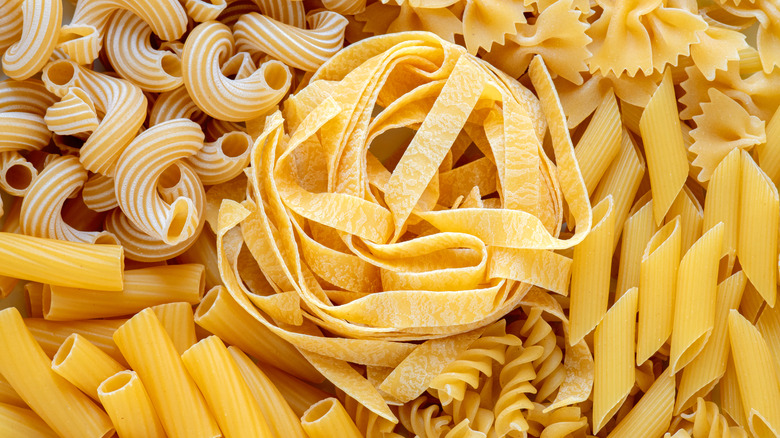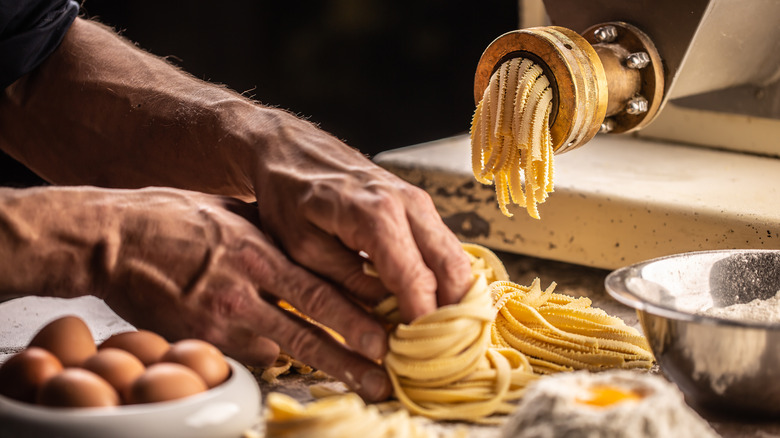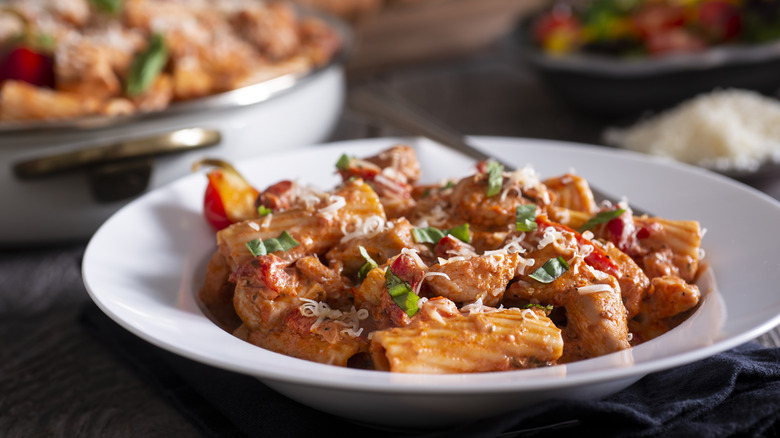Bronze-Cut Pasta Is Not Your Average Noodle
There is something simply delightful and utterly unique about the vast array of pasta shapes available in a single grocery store aisle, but when you are hungry or in a bit of a rush, the multitude of options can feel overwhelming. If you have found yourself standing in front of shelves of fusilli and rigatoni recently, scanning the packages to decide which one will best suit your craving, you may have noticed the term "bronze-cut pasta" and wondered how this factors into your choice. For those who like a well-sauced plate of pasta, this may be your best option.
This particular piece of marketing vocabulary specifically refers to the process of producing pasta. Whether at home or in a factory, certain pasta shapes are made by extruding dough through a machine. These machines were traditionally coated with bronze, but today, many of them are instead coated with Teflon. Bronze-cut pasta has a relatively coarse texture, which makes it ideal for catching a thick coating of sauce.
Why the pasta machine material matters
To understand what it is that makes bronze-cut pasta special, it is important to understand the differences between bronze — a metal alloy invented thousands of years ago — and Teflon — the brand most commonly known for the chemical coating polytetrafluoroethylene, which was invented almost a century ago and is used on nonstick pans. Teflon was introduced as a coating for pasta-making machines because it creates a smoother surface, which increases the speed of the production process. This allows factories to make more pasta in a short time, helping them to reduce its price.
Using a bronze-coated machine is the more traditional option, but it takes more time, so the pasta is generally more expensive. If you're wondering why the material of the machine matters, it boils down to this: The smooth surface of Teflon-coated machines results in smooth pieces of pasta — while bronze-cut pasta has a rougher consistency. The more nooks and crannies on the surface of pasta, the more sauce you get in every bite.
How to make the most of your bronze-cut pasta
Because bronze-cut pasta can have a higher price tag, you want to make sure you're making the most of it. (It's worth noting that the cost may also be higher for other quality reasons, such as the use of heirloom grains in the dough.) Since this kind of pasta does especially well with a hearty serving of sauce, take care to choose the best pasta shape for your sauce. You may even want to go the extra mile and make tomato sauce from scratch. If that's not your style, bronze-cut pasta works well with a broad range of toppings, from pesto to carbonara to cacio e pepe.
One of the other great characteristics of this particular pasta is that it does a good job of maintaining an al dente texture when cooked. While other kinds of pasta can quickly become mushy, the rough exterior of bronze-cut pasta helps ensure every bite has a delicious chewiness. To get the best texture, set your timer so that your pasta cooks for a minute less than the recommended amount on the packaging, then use a fork to carefully remove a piece to test it before draining the whole pot.



